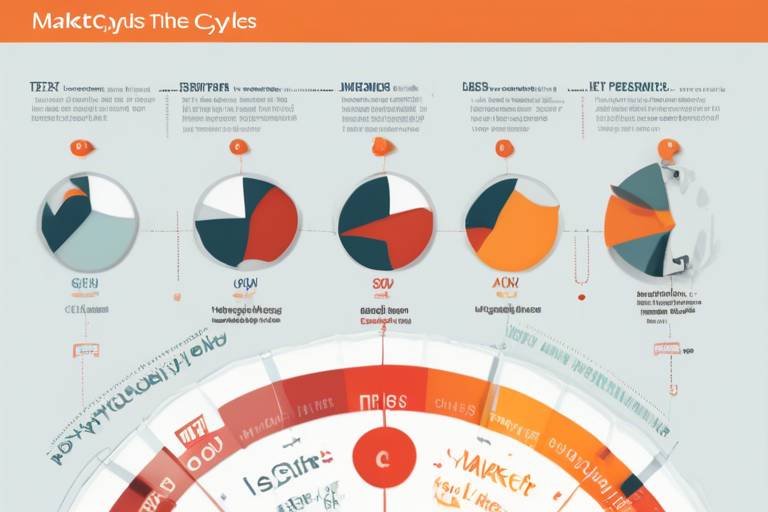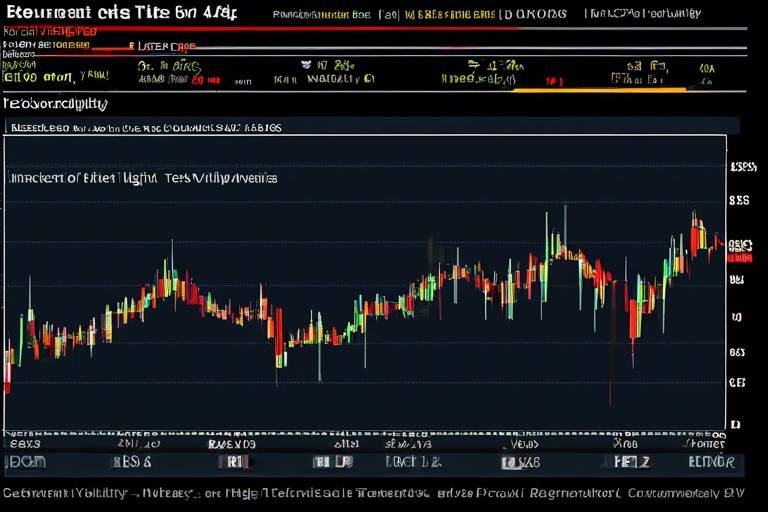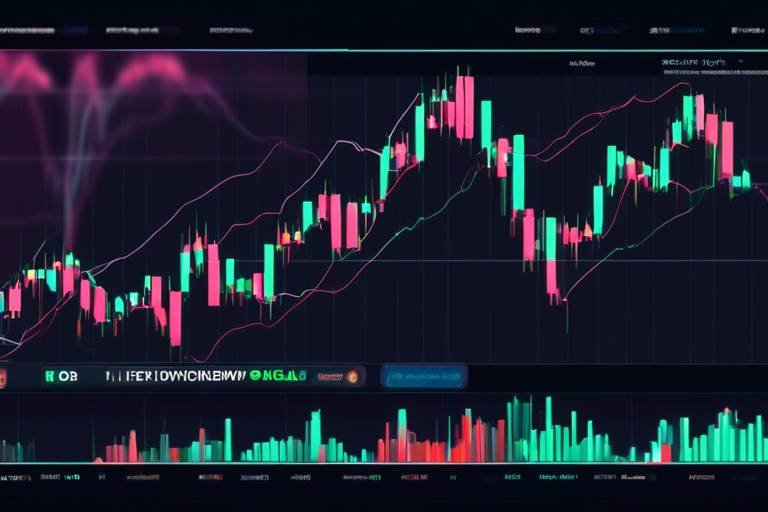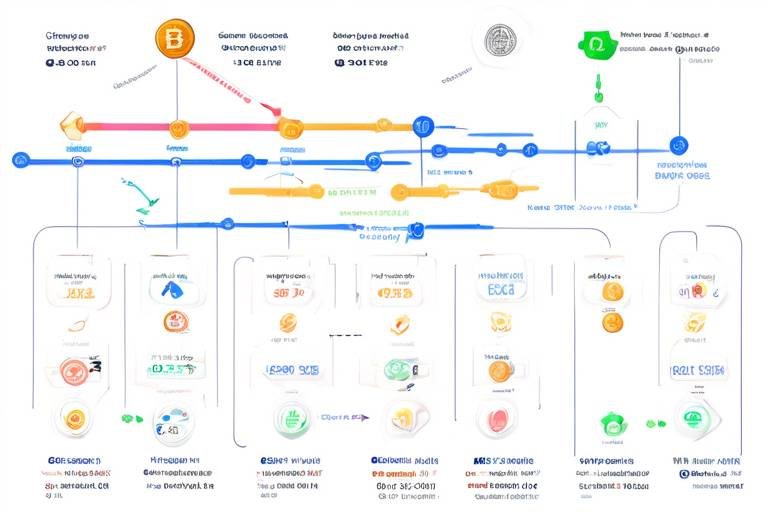The Significance of Divergence in Crypto Trading
Divergence in crypto trading is not just a buzzword; it's a powerful concept that can significantly influence your trading decisions. Imagine you're navigating a ship through turbulent waters, and suddenly, the compass starts pointing in a different direction than the waves. That's what divergence feels like in the world of cryptocurrency. It indicates that the market might be signaling a shift, whether you're ready for it or not. Understanding this phenomenon can be the difference between riding the wave to success or being capsized by unexpected losses.
So, what exactly is divergence? In simple terms, it occurs when the price of a cryptocurrency moves in the opposite direction of an indicator, such as the Relative Strength Index (RSI) or Moving Average Convergence Divergence (MACD). This discrepancy can hint at potential reversals in market trends, making it crucial for traders aiming to enhance their predictive capabilities. By recognizing divergence, traders can position themselves strategically, either to capitalize on upcoming trends or to safeguard their investments against downturns.
Why is this important? Well, the cryptocurrency market is notoriously volatile. Prices can fluctuate wildly within minutes, and having a reliable method to predict these movements can be invaluable. Divergence acts as a lighthouse, guiding traders through the fog of uncertainty. It helps them identify when to enter or exit trades, thereby optimizing their trading strategies and potentially increasing their profitability. In essence, understanding divergence is like having a secret weapon in your trading arsenal.
Moreover, incorporating divergence into your trading approach isn't just about spotting trends; it's about making informed decisions. Traders who ignore these signals may find themselves blindsided by sudden market shifts, leading to missed opportunities or, worse, significant losses. By paying attention to divergence, you're not only enhancing your analysis but also empowering yourself to make better choices in a fast-paced trading environment.
In conclusion, the significance of divergence in crypto trading cannot be overstated. It's a critical tool that, when understood and applied correctly, can lead to more successful trading outcomes. Whether you're a novice just dipping your toes into the crypto waters or a seasoned trader looking to refine your strategies, grasping the concept of divergence is essential. So, keep your eyes peeled for those signals; they might just be the key to unlocking your trading potential.
- What is divergence in crypto trading? Divergence occurs when the price of a cryptocurrency moves in the opposite direction of an indicator, signaling potential reversals.
- Why is divergence important? It helps traders identify potential trend reversals and make informed decisions, enhancing their trading strategies.
- What are the types of divergence? The two main types are regular divergence and hidden divergence, each providing different insights into market trends.
- How can I use divergence in my trading strategy? By combining divergence analysis with other indicators and volume analysis, traders can improve their decision-making and risk management.

Understanding Divergence
Divergence is a fascinating concept in the world of cryptocurrency trading, and it can be a game-changer for traders looking to enhance their market analysis skills. Essentially, divergence occurs when the price of a cryptocurrency moves in a direction that is opposite to an indicator, such as the Relative Strength Index (RSI) or Moving Average Convergence Divergence (MACD). This discrepancy can signal potential reversals in price trends, making it a crucial tool for traders who want to stay ahead of the curve.
Think of divergence as a warning light on your dashboard. Just like a car's engine light that tells you something might be wrong, divergence alerts traders that the current price movement may not be sustainable. It’s like watching a tightrope walker who seems to be losing balance; you know something is about to happen. By understanding divergence, traders can enhance their predictive capabilities and make more informed decisions.
To grasp the significance of divergence, it's important to recognize that it can manifest in two primary forms: regular divergence and hidden divergence. Each type provides unique insights into market trends and potential price movements. Regular divergence, for instance, often indicates a possible trend reversal, while hidden divergence may suggest the continuation of an existing trend. By learning to identify these patterns, traders can better navigate the turbulent waters of the cryptocurrency market.
Moreover, the ability to spot divergence can significantly improve a trader's strategy. It’s not just about recognizing the divergence itself; it’s also about understanding the context in which it occurs. For example, if a cryptocurrency is experiencing a bullish divergence while the overall market sentiment is positive, this could reinforce the likelihood of an upward price movement. On the other hand, a bearish divergence in a downtrending market might suggest a stronger sell-off is imminent.
In summary, understanding divergence is not just about identifying discrepancies between price and indicators; it's about using that knowledge to make strategic trading decisions. By integrating divergence analysis into their trading toolkit, traders can arm themselves with valuable insights that enhance their ability to predict market movements and optimize their trading strategies.

Types of Divergence
Divergence in crypto trading is not a one-size-fits-all concept; rather, it comes in various forms that traders must understand to navigate the volatile waters of the cryptocurrency market effectively. The two primary types of divergence are regular divergence and hidden divergence. Each type serves a unique purpose and provides different insights into market trends, which can be invaluable for traders looking to make informed decisions.
Regular divergence is often a signal of a potential trend reversal. It occurs when the price of a cryptocurrency moves in one direction while an indicator, such as the Relative Strength Index (RSI) or Moving Average Convergence Divergence (MACD), moves in the opposite direction. This discrepancy can act as a warning sign for traders, indicating that the current trend may be losing momentum. In contrast, hidden divergence suggests a continuation of the existing trend rather than a reversal. Recognizing this type of divergence can help traders confirm that the trend is still strong and viable, allowing them to make more strategic decisions.
To better illustrate these concepts, consider the following table that summarizes the key differences between regular and hidden divergence:
| Type of Divergence | Indicates | Action for Traders |
|---|---|---|
| Regular Divergence | Potential trend reversal | Consider entering/exiting positions |
| Hidden Divergence | Trend continuation | Confirm existing trend and hold positions |
Understanding these two types of divergence can significantly enhance a trader's predictive capabilities. For instance, when a trader identifies a bearish regular divergence, where the price reaches higher highs while the momentum indicator shows lower highs, it suggests that the market may be losing strength. This could prompt the trader to consider selling their position or tightening their stop-loss orders to protect their capital. Conversely, a bullish regular divergence, characterized by lower lows in price and higher lows in indicators, can signal a potential uptrend, encouraging traders to enter long positions and capitalize on the anticipated price increase.
On the other hand, recognizing hidden divergence can be equally crucial. For example, if the price is making higher lows while the momentum indicators are also showing higher lows, it reaffirms the strength of the uptrend. This insight allows traders to maintain their positions with greater confidence, knowing that the trend is likely to continue. In both cases, understanding the nuances of divergence can empower traders to make decisions that align with market conditions.
In summary, grasping the differences between regular and hidden divergence is essential for any trader looking to enhance their trading strategies. By integrating this knowledge into their market analysis, traders can not only improve their decision-making but also increase their chances of success in the fast-paced world of cryptocurrency trading.

Regular Divergence
Regular divergence is a fascinating concept in the realm of crypto trading, acting as a beacon for traders navigating the tumultuous waters of the market. It occurs when the price of a cryptocurrency moves in a direction that is opposite to the momentum indicators, such as the Relative Strength Index (RSI) or the Moving Average Convergence Divergence (MACD). This phenomenon is crucial for traders because it often signals potential trend reversals, providing valuable insights into when to enter or exit a position. Imagine you're sailing on a boat, and the wind suddenly shifts direction; understanding regular divergence is akin to adjusting your sails to harness that new wind for a successful journey.
Recognizing regular divergence can be a game-changer for traders. It allows them to spot key moments when the market sentiment may be shifting, which is particularly important in the highly volatile world of cryptocurrencies. For instance, when the price of an asset is making higher highs while the momentum indicators are forming lower highs, it indicates a bearish regular divergence. This is like a warning light on your dashboard, suggesting that it might be time to reconsider your position. Conversely, when prices are creating lower lows, but the indicators are forming higher lows, this bullish regular divergence could be a signal to jump into a long position.
To further illustrate the significance of regular divergence, let's take a look at a hypothetical scenario:
| Price Movement | Momentum Indicator | Signal |
|---|---|---|
| Higher Highs | Lower Highs | Bearish Regular Divergence (Sell Signal) |
| Lower Lows | Higher Lows | Bullish Regular Divergence (Buy Signal) |
By keeping an eye on these divergence signals, traders can make more informed decisions, potentially increasing their profitability. It's essential to remember that while regular divergence is a powerful tool, it should not be used in isolation. Combining it with other technical analysis tools and indicators can provide a more comprehensive view of the market landscape. This holistic approach is akin to assembling a puzzle; each piece contributes to a clearer picture of market dynamics.
In summary, understanding regular divergence is vital for any crypto trader looking to enhance their predictive capabilities. By recognizing these signals, traders can better position themselves in the market, whether that means tightening stop losses during a bearish phase or capitalizing on bullish momentum. As with any trading strategy, practice and experience will hone your ability to spot these divergences effectively, leading to improved decision-making and greater trading success.

Bearish Regular Divergence
Bearish regular divergence is a critical concept in crypto trading that every trader should be aware of. It occurs when the price of a cryptocurrency reaches higher highs, while a momentum indicator, such as the Relative Strength Index (RSI) or Moving Average Convergence Divergence (MACD), forms lower highs. This discrepancy between price action and momentum signals a potential downtrend, indicating that the bullish momentum is weakening. In simpler terms, it's like a runner who is sprinting forward but is clearly losing steam; this mismatch can be a red flag for traders.
Recognizing bearish regular divergence is essential for making informed trading decisions. When traders spot this pattern, it can serve as a warning sign to consider selling positions or tightening stop-loss orders. Think of it as a lighthouse in a stormy sea, guiding you away from potential losses. The divergence suggests that buyers are losing control and that sellers may start to dominate the market. This shift can lead to a price correction, making it a prime opportunity for traders to capitalize on the downturn.
To illustrate, let's consider an example with hypothetical data:
| Time Period | Price | RSI Value |
|---|---|---|
| Day 1 | $10,000 | 70 |
| Day 2 | $10,500 | 65 |
| Day 3 | $11,000 | 60 |
In this example, as the price of the cryptocurrency rises from $10,000 to $11,000 over three days, the RSI value decreases from 70 to 60. This scenario illustrates bearish regular divergence, indicating that while the price is climbing, the momentum is fading. Traders observing this pattern might consider it a signal to either take profits or prepare for a potential sell-off.
Moreover, understanding the implications of bearish regular divergence can significantly enhance your trading strategy. By incorporating this knowledge, traders can better manage their risk and protect their capital. It’s crucial to remember that while divergence is a powerful tool, it should not be used in isolation. Combining it with other indicators and market analysis can lead to more robust trading decisions.
In summary, bearish regular divergence serves as a vital indicator of potential market reversals. Recognizing this pattern can empower traders to make timely and informed decisions, ultimately leading to better trading outcomes. So, the next time you analyze the market, keep an eye out for those divergence signals—they could be the key to your success!
- What is bearish regular divergence? It occurs when the price of a cryptocurrency makes higher highs while a momentum indicator makes lower highs, signaling a potential downtrend.
- How can I identify bearish regular divergence? Look for price movements that contrast with momentum indicators like RSI or MACD. If prices are rising but indicators are falling, you may have spotted bearish divergence.
- What should I do when I spot bearish regular divergence? Consider tightening your stop-loss orders or taking profits, as this pattern may indicate that a price correction is on the horizon.
- Is bearish regular divergence always reliable? While it can be a strong indicator, it is best used in conjunction with other analysis methods to confirm potential market movements.

Bullish Regular Divergence
Bullish regular divergence is a powerful signal that traders often look for when analyzing price movements in the cryptocurrency market. This phenomenon occurs when the price of a cryptocurrency makes lower lows, while the momentum indicator, such as the Relative Strength Index (RSI) or Moving Average Convergence Divergence (MACD), forms higher lows. This discrepancy between price action and momentum can be a strong indication that the downward trend is losing strength, paving the way for a potential upward reversal.
Understanding this concept is crucial for traders who wish to capitalize on market opportunities. When a trader identifies bullish regular divergence, it’s akin to spotting a light at the end of a tunnel. It suggests that despite the price continuing to dip, the underlying strength of the asset is improving, which can lead to a significant price bounce. This is especially vital in the highly volatile world of cryptocurrencies, where market sentiment can shift rapidly.
To illustrate this concept further, consider the following example: imagine a cryptocurrency that has been on a downward spiral. As prices continue to fall, a trader observes that the RSI is beginning to trend upwards. This divergence signals that while the price is dropping, the momentum is building for a potential reversal. It’s like watching a coiled spring; the tighter it gets, the more powerful the release will be once it finally snaps back. Recognizing this divergence can help traders make informed decisions about entering long positions before the market fully turns around.
Moreover, traders can enhance their analysis by combining bullish regular divergence with other indicators. For instance, if a trader notices bullish divergence alongside increasing trading volume, it adds further credence to the signal. The combination of these indicators can create a more robust trading strategy, increasing the likelihood of successful trades. Here’s a quick breakdown:
| Indicator | Signal |
|---|---|
| Price Action | Lower Lows |
| Momentum Indicator (e.g., RSI) | Higher Lows |
| Volume | Increasing Volume |
In summary, bullish regular divergence serves as a critical tool for traders looking to navigate the unpredictable waters of cryptocurrency trading. By recognizing this pattern, traders can position themselves strategically to take advantage of potential price reversals. Just remember, while bullish divergence can be a promising indicator, it’s essential to remain cautious and consider other factors, such as market trends and external news, which may influence price movements. After all, in the world of trading, it’s not just about spotting the signs; it’s about interpreting them correctly and acting wisely.
- What is bullish regular divergence?
Bullish regular divergence occurs when the price of an asset makes lower lows while a momentum indicator forms higher lows, indicating a potential upward reversal.
- How can I identify bullish regular divergence?
Traders can identify bullish regular divergence by comparing price action with momentum indicators like RSI or MACD. Look for lower lows in price and higher lows in the indicator.
- Is bullish divergence a guaranteed signal for price increases?
No, while bullish divergence can indicate a potential reversal, it is not a guarantee. Traders should consider other factors and indicators before making trading decisions.

Hidden Divergence
Hidden divergence is a fascinating concept in the realm of cryptocurrency trading, often overlooked by many traders. Unlike regular divergence, which signals potential reversals, hidden divergence suggests that the prevailing trend is likely to continue. Imagine you're driving on a long, winding road; just when you think the journey might take a detour, the road straightens out again, confirming that you’re on the right path. Similarly, hidden divergence can serve as a confirmation tool for traders, reinforcing the strength of an ongoing trend.
To grasp the power of hidden divergence, it's crucial to recognize how it manifests in market indicators. Typically, this phenomenon occurs when the price of a cryptocurrency is making a higher low while the corresponding momentum indicator is making a lower low. This discrepancy signals that, despite a temporary dip in price, the underlying momentum is still strong, suggesting that the uptrend is likely to persist. Conversely, in a downtrend, hidden divergence appears when the price makes a lower high while the indicator makes a higher high, indicating that the downtrend remains intact.
Traders can leverage hidden divergence in several ways. For instance, when they spot hidden divergence on a chart, they might consider it a green light to hold onto their positions or even add to them, confident that the trend will continue. It's akin to a surfer catching the wave just right, riding it all the way to the shore instead of jumping off prematurely. However, it's essential to combine hidden divergence with other indicators, such as volume or moving averages, to bolster the reliability of the signals being generated.
Moreover, hidden divergence can be particularly useful in volatile markets, where price swings can be dramatic and misleading. By understanding the nuances of hidden divergence, traders can make more informed decisions, reducing the likelihood of being caught off guard by sudden market shifts. In essence, hidden divergence acts like a lighthouse in a stormy sea, guiding traders safely through the tumultuous waters of crypto trading.
- What is the difference between regular and hidden divergence?
Regular divergence signals a potential trend reversal, while hidden divergence indicates that the current trend is likely to continue. - How can I identify hidden divergence in my trading?
Look for instances where the price makes a higher low in an uptrend or a lower high in a downtrend, while the momentum indicator shows the opposite. - Should I rely solely on hidden divergence for my trading decisions?
No, it's best to combine hidden divergence with other indicators to enhance the accuracy of your trading signals. - Can hidden divergence be used in all markets?
Yes, hidden divergence can be applied to various markets, including stocks, forex, and cryptocurrencies.

Using Divergence in Trading Strategies
Divergence is not just a fancy term thrown around in crypto trading circles; it’s a powerful tool that can significantly enhance your trading strategies. By understanding and applying the concept of divergence, traders can gain valuable insights into market behavior, which can ultimately lead to more informed and profitable trading decisions. Imagine you’re a detective, piecing together clues to solve a mystery—divergence acts as one of those clues that can guide you toward making the right moves in the market.
When incorporating divergence into your trading strategies, it’s essential to combine it with other indicators. This multifaceted approach can provide a more comprehensive view of market conditions. For instance, using divergence alongside moving averages or Relative Strength Index (RSI) can help validate your findings. Think of it as having a trusty sidekick; while divergence gives you hints about potential reversals or continuations, these other indicators can confirm those hunches, leading to a much stronger trading decision.
Moreover, understanding how to interpret divergence signals can vastly improve your entry and exit points. For example, if you spot a bullish divergence while the RSI is also indicating an oversold condition, it’s like finding a treasure map that leads you straight to the gold. This combination not only boosts your confidence in entering a trade but also helps you set realistic price targets and stop-loss levels, minimizing your risk.
Another critical aspect of using divergence in trading strategies is its role in risk management. Recognizing divergence signals can aid traders in setting appropriate stop-loss orders. For instance, if you identify a bearish divergence, it might be wise to tighten your stop-loss to protect your capital from potential downturns. This proactive approach can be the difference between a minor setback and a significant loss.
To illustrate how divergence can be effectively used in trading strategies, let’s look at a simple table summarizing the key components:
| Divergence Type | Market Signal | Recommended Action |
|---|---|---|
| Bearish Regular Divergence | Potential downtrend | Consider selling or tightening stop-loss |
| Bullish Regular Divergence | Potential uptrend | Consider entering long positions |
| Hidden Divergence | Trend continuation | Hold positions or look for entry points |
In conclusion, using divergence in your trading strategies is like having a secret weapon at your disposal. It can enhance your decision-making process, improve your entry and exit points, and bolster your risk management efforts. By integrating divergence with other indicators and maintaining a keen eye on market trends, you can navigate the often-turbulent waters of cryptocurrency trading with greater confidence and success.
- What is divergence in crypto trading? Divergence occurs when the price of a cryptocurrency moves in the opposite direction of an indicator, signaling potential reversals.
- How can I identify divergence? Traders can identify divergence by comparing price action with indicators like RSI or MACD to spot discrepancies.
- Is divergence a reliable trading signal? While divergence can provide valuable insights, it should be used in conjunction with other indicators for better accuracy.
- Can divergence predict market reversals? Yes, divergence can indicate potential trend reversals, but it’s essential to confirm with additional analysis.

Combining Divergence with Volume Analysis
When it comes to trading in the cryptocurrency market, the importance of volume analysis cannot be overstated. Pairing this with divergence can create a powerful toolkit for traders looking to enhance their decision-making capabilities. So, how does this combination work? Think of divergence as a signal that indicates a potential change in price direction, while volume analysis serves as the fuel that can either support or contradict that signal. Together, they form a comprehensive view of market dynamics.
To illustrate, let’s break down the synergy between these two concepts. When you observe a divergence—say, a bullish divergence where the price is making lower lows but the volume is increasing—it could indicate that the selling pressure is weakening. This situation becomes a potential entry point for traders looking to capitalize on a possible price reversal. Conversely, if a bearish divergence occurs alongside decreasing volume, it might suggest that the upward momentum is losing steam, which could be a red flag for traders.
Furthermore, utilizing volume analysis can help confirm the strength of a divergence signal. For example, if you notice a bullish divergence on a momentum indicator and, simultaneously, the volume spikes, it adds credibility to the bullish signal. This means that traders are actively participating in the market, which can lead to stronger price movements. On the flip side, a divergence accompanied by low volume might indicate a lack of conviction, making it a less reliable signal.
Here’s a quick overview of how to effectively combine these two analyses:
- Identify Divergence: Look for either regular or hidden divergence on your chosen indicators.
- Analyze Volume: Check the volume trends accompanying the divergence. Is the volume increasing or decreasing?
- Confirm Signals: Use the volume data to confirm the strength of the divergence signal before making trading decisions.
By incorporating volume analysis into your divergence strategy, you can refine your trading approach. This not only enhances your ability to make informed decisions but also helps mitigate risk. Remember, trading is as much about understanding the market's psychology as it is about analyzing charts. The more tools you have at your disposal, the better prepared you will be to navigate the often unpredictable waters of cryptocurrency trading.
- What is divergence in crypto trading? Divergence occurs when the price of a cryptocurrency moves in the opposite direction of an indicator, signaling possible trend reversals.
- How can I identify regular divergence? Regular divergence is identified when price action diverges from momentum indicators, such as RSI or MACD.
- What is the importance of volume in trading? Volume indicates the strength or weakness of a price movement. High volume can confirm trends, while low volume may suggest a lack of conviction.
- Can I rely solely on divergence for trading decisions? While divergence is a valuable tool, it’s best used in conjunction with other indicators and analyses for more reliable trading strategies.

Divergence and Risk Management
Understanding divergence is essential for effective risk management in the world of cryptocurrency trading. Traders who can identify divergence signals are better equipped to make informed decisions that can protect their capital during uncertain market conditions. This is because divergence often indicates potential price reversals or continuations, which can be crucial for setting stop-loss orders and determining entry and exit points.
For instance, when a trader observes a bearish regular divergence, where the price is making higher highs while the momentum indicator is forming lower highs, it serves as a warning sign. This discrepancy signals that the upward momentum is weakening, and a downtrend may be on the horizon. In such a scenario, traders might consider tightening their stop-loss orders or even exiting their positions to minimize potential losses.
On the flip side, bullish regular divergence can provide a glimmer of hope in a downtrending market. Here, the price makes lower lows while the indicator establishes higher lows, suggesting that a reversal to the upside could be imminent. Traders can use this information to strategically enter long positions, thereby capitalizing on the anticipated price rise.
Moreover, integrating divergence into a broader risk management strategy can enhance overall trading effectiveness. For example, a trader might develop a comprehensive plan that includes:
- Identifying divergence patterns on multiple time frames to confirm signals.
- Setting stop-loss orders just below support levels in bullish divergence scenarios.
- Utilizing trailing stops to lock in profits as the price moves in favor of the trade.
Furthermore, it’s vital to remember that no single indicator should be relied upon in isolation. Combining divergence analysis with other tools, such as volume indicators and trend lines, can provide a more robust framework for risk management. For instance, if a trader notices divergence along with a spike in volume, it may serve as a stronger confirmation of a potential price movement, prompting them to adjust their risk accordingly.
In summary, recognizing and understanding divergence is not just about spotting potential trading opportunities; it's also about safeguarding your investments. By incorporating divergence into your risk management strategy, you can better navigate the unpredictable waters of cryptocurrency trading and enhance your overall success.
- What is divergence in crypto trading? Divergence occurs when the price of a cryptocurrency moves in the opposite direction of an indicator, signaling potential reversals.
- How can divergence improve my trading strategy? By recognizing divergence patterns, you can identify potential entry and exit points, enhancing your decision-making process.
- What are the types of divergence? The two main types are regular divergence (bearish and bullish) and hidden divergence.
- Why is risk management important in trading? Effective risk management helps protect your capital and minimizes losses during market volatility.
Frequently Asked Questions
- What is divergence in crypto trading?
Divergence in crypto trading refers to a situation where the price of a cryptocurrency moves in the opposite direction of a technical indicator, such as an oscillator. This phenomenon can signal potential reversals in market trends, making it a crucial concept for traders looking to enhance their predictive capabilities.
- What are the main types of divergence?
There are two primary types of divergence: regular divergence and hidden divergence. Regular divergence indicates a potential trend reversal, while hidden divergence suggests trend continuation. Understanding both types helps traders make informed decisions based on market behavior.
- How can I identify regular bearish divergence?
Regular bearish divergence occurs when the price reaches higher highs, but the momentum indicator shows lower highs. This discrepancy suggests a potential downtrend, alerting traders to consider selling positions or tightening their stop losses to protect their investments.
- What does bullish regular divergence indicate?
Bullish regular divergence is identified when prices hit lower lows while the indicators form higher lows. This scenario often suggests a possible uptrend, providing a strong signal for traders to enter long positions and capitalize on potential price increases.
- How does hidden divergence differ from regular divergence?
Hidden divergence differs from regular divergence in that it indicates trend continuation instead of reversal. Recognizing hidden divergence helps traders confirm existing trends, allowing them to make more strategic trading decisions based on ongoing market momentum.
- Can I combine divergence with other trading indicators?
Absolutely! Combining divergence analysis with other indicators, such as volume analysis, can enhance the reliability of trading signals. This multi-faceted approach increases the chances of successful trades in volatile markets, giving traders a better edge.
- How can divergence analysis assist in risk management?
Divergence analysis plays a vital role in risk management by providing signals that help traders set appropriate stop-loss orders. By understanding divergence, traders can better protect their capital during uncertain market conditions, reducing the risk of significant losses.


















